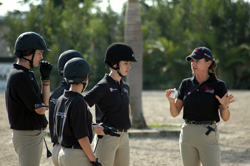Reprinted from the August 2008 issue of Practical Horseman magazine. To learn how to analyze show-jumping questions to maximize performance from the designer himself, see “The Heartbeat of a Course” in the February 2010 issue.
Course designer Steve Stephens remembers sitting on the steps at the Pennsylvania National Horse Show in Harrisburg as a teenager waiting to ride, looking at the courses and thinking of alternatives. He’d sketch them out as he surveyed what already had been built in the ring.

“I got into it by critiquing what someone else had done,” he notes. He’d see a jumpoff line to the left and think, “It would have been better if it went to the right.”
Soon others started noticing what he was doing.
“One day, [Olympian] Billy Steinkraus walked by me and gave me a couple of pointers–of course, that was, ‘Oh my God, Billy Steinkraus talked to me!'” chuckles Steve. Little did he or the U.S. Equestrian Team captain and Olympic individual show-jumping gold medalist realize that someday Steve would be involved with the Olympics himself.
The highlight of Steve’s career to date will be unveiled in Hong Kong as he lays out the Olympic show-jumping routes with Leopoldo Palacios of Venezuela. Although many of their expenses are covered by the Beijing Olympic Organizing Committee, they are not getting paid for designing. But Steve doesn’t care. “It’s my Oscar,” he says.
For more than four decades, Steve, 58, has been a partner in Imperial Farms in Palmetto, Fla., with show impresario Gene Mische, who gave him his first break in designing courses at a show Gene ran on Long Island in the 1970s.
“He believed I could do it,” says Steve, whose designing career escalated from there and took him around the world. Multitalented, he also builds jumps. He began his company, Stephens Designs, in 1992 after making a decision to focus on course designing rather than riding. The business produces the artistic and intriguing obstacles seen at the Winter Equestrian Festival, the Budweiser American Invitational, the American Gold Cup, the Devon Horse Show and many other of the country’s best-known hunter/jumper shows. Their style and color add another dimension to every big class.
Although the firm employs five people, Steve does the final designs and much of the painting, but he can perform every job involved in the fence-building process. It’s not uncommon to find him covered with fiberglass dust in the shop after working on a project, and he revels in being hands-on.
The jumps are an outlet for Steve’s flair and imagination. “I enjoy the art of it,” he says. His patriotism is reflected in American flag obstacles. He produces a wide range of beautiful objects, from wavy viaducts to standards topped with gleaming copper cupolas and adobe houses that look as if they are in move-in condition.
Whatever he does in terms of fence building or course design, the welfare of the horse is first in Steve’s mind. As a former top rider who is married to grand prix show-jumper Debbie Stephens, he has a special understanding of what horses can achieve, as well as what they shouldn’t be asked to do.
“Let’s go out and see how big we can make it, let’s see who can survive–that will not be our object, for sure,” Steve emphasizes in his southern drawl as he talks about what is planned for Hong Kong. “It’s up to the riders to solve the test. It’s not us against them, it’s them against the day of the event,” Steve says.
He was strongly influenced by the late Bertalan de N?methy, the former USET show-jumping coach and a master designer. De N?methy, Steve notes, was responsible for a turning point in the sport with his courses for the 1984 Olympics. Rather than the power jumping that ended the careers of so many horses in previous Olympics, Bert emphasized the technical aspects of the sport, using lighter rails to make it more about technique than muscle. He put a premium on the rider’s skill and judgment, as well as the horse’s confidence and cooperation with the rider. Steve learned those lessons well and has amplified them through the years.
While the Hong Kong courses will show regard for the competitors, both equine and human, the whole package is intended to be a test worthy of the greatest Games on earth.
“It will be strong,” Steve promises. “It’s not going to be a cakewalk.”










